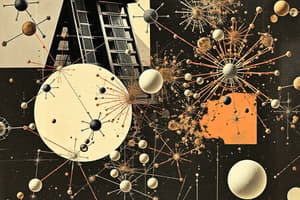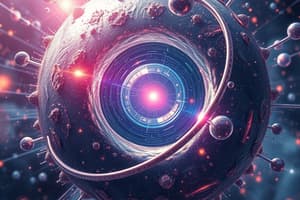Podcast
Questions and Answers
What happens to the spaces between particles of a substance when the substance contracts?
What happens to the spaces between particles of a substance when the substance contracts?
- The spaces remain the same.
- The spaces decrease. (correct)
- The spaces fluctuate.
- The spaces increase.
How does gas pressure change with temperature?
How does gas pressure change with temperature?
- Decreases with temperature.
- Remains constant with temperature.
- Fluctuates with temperature.
- Increases with temperature. (correct)
Which statement best describes atmospheric pressure?
Which statement best describes atmospheric pressure?
- Pressure exerted by gas particles in the atmosphere. (correct)
- Pressure exerted by solid particles in the atmosphere.
- Pressure exerted by plasma particles in the atmosphere.
- Pressure exerted by liquid particles in the atmosphere.
What does density of a substance indicate?
What does density of a substance indicate?
When an object is denser than its surrounding medium, what happens to the object?
When an object is denser than its surrounding medium, what happens to the object?
How does density change with temperature for liquid or gas particles?
How does density change with temperature for liquid or gas particles?
What effect does decreasing the volume of a closed container have on gas pressure?
What effect does decreasing the volume of a closed container have on gas pressure?
How does cooling affect the movement of particles in a substance?
How does cooling affect the movement of particles in a substance?
What is the term used to describe the process where solute particles move apart and become evenly distributed among solvent particles?
What is the term used to describe the process where solute particles move apart and become evenly distributed among solvent particles?
What law states that the total mass of solute and solvent is conserved in dissolving?
What law states that the total mass of solute and solvent is conserved in dissolving?
In dissolving, what may differ from the sum of the volumes of the solute and solvent?
In dissolving, what may differ from the sum of the volumes of the solute and solvent?
What phenomenon is observed when substances expand upon heating and contract upon cooling?
What phenomenon is observed when substances expand upon heating and contract upon cooling?
What effect does heating have on the movement of particles within a substance?
What effect does heating have on the movement of particles within a substance?
Which state of matter is characterized by particles being closely packed in a regular pattern and vibrating about a fixed position?
Which state of matter is characterized by particles being closely packed in a regular pattern and vibrating about a fixed position?
What term describes the process where solute particles are evenly distributed among solvent particles?
What term describes the process where solute particles are evenly distributed among solvent particles?
'Each vibrates about a fixed position' is a characteristic used to define which state of matter?
'Each vibrates about a fixed position' is a characteristic used to define which state of matter?
What is the basic unit of matter?
What is the basic unit of matter?
What does the particle theory state about the particles in matter?
What does the particle theory state about the particles in matter?
Which statement accurately describes the movement of particles in gases?
Which statement accurately describes the movement of particles in gases?
What is the role of molecules in forming matter?
What is the role of molecules in forming matter?
How does the particle model describe the arrangement of particles in solids?
How does the particle model describe the arrangement of particles in solids?
Which characteristic differentiates particles in various substances according to the text?
Which characteristic differentiates particles in various substances according to the text?
What is the significant difference between atoms and molecules based on the text?
What is the significant difference between atoms and molecules based on the text?
How do particles in liquids differ from particles in gases based on the text?
How do particles in liquids differ from particles in gases based on the text?
Flashcards are hidden until you start studying




